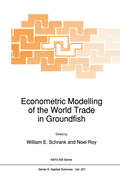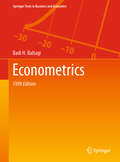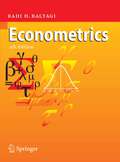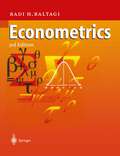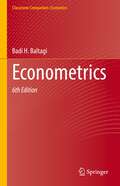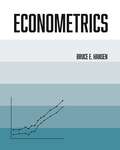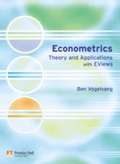- Table View
- List View
Econometric Modelling of the World Trade in Groundfish (NATO Science Series E: #201)
by W. E Schrank Noel RoyThis conference brought together an international group of fisheries economists from academia, business, government, and inter-governmentalagencies, to consider a coordinated project to build an econometric model of the world trade in groundfish. A number of the conference participants had just spent up to six weeks at Memorial University of Newfoundland working and preparing papers on the project. This volume presents the papers that these scholars produced, plus additional papers prepared by other conference participants. In addition, various lectures and discussionswhich were transcribed from tapes made of the proceedings are included. The introductory essay explains the genesis of the conference, describes the approach taken to modelling the groundfish trade, very briefly summarizes the technical papers, and describes future plans. The project is continuing as planned, and a second conference was held in St. John's in August 1990. The conference was a NATO Advanced Research Workshop and we wish to thank the ScientificAffairs Division ofNATO for their financial support. Additional financial support was received from the Canadian Centre for Fisheries Innovation in St. John's, the Department of Fisheries and Oceans of the Government of Canada, the Department of Fisheries of the Government of Newfoundland and Labrador, Memorial University of Newfoundland and Air Nova; we acknowledge with appreciation their help.
Econometric Models of Asian Link
by Shinichi Ichimura Mitsuo EzakiThis is the first outcome of our effort in ASIAN LINK PROJECT to construct the econometric models of Asian developing countries and analyze their inter-dependence with major trading partners, the United States and Japan. The model we present here is called Asian Link System. The countries in this system include Korea, Taiwan, Hong Kong, China, the Philippines, Thailand, Malaysia, Singapore, Indonesia, Japan and the United States. They are covered by national models. The rest of the world is divided into several regions and treated by simple proto-type models. The main characteristics of Asian Link System are to deal with the inter-dependent relations between Asian developing countries on the one hand and Japan and United States on the other hand. Here are presented these national models and the Asian Link System with the underlying statistical data, so that any econometrician can re-estimate our models and check the results of our research work. Nowadays most articles and books in econometrics report only the final results or conclusions of research so that no other econometrician can re-calculate or re examine the findings. This is very serious in the empirical research, because as theorists may make mistakes, positive economists do commit errors or miss some possible considerations. Unless statiscal data are offered, other econometricians cannot make suggestions or improve the models. This is the main reason why empirical research in econometrics or applied econometrics are not making substantial progress in recent years.
The Econometricians: Gauss, Galton, Pearson, Fisher, Hotelling, Cowles, Frisch and Haavelmo (Great Minds in Finance)
by Colin ReadThis is the seventh book in a series of discussions about the great minds in the history and theory of finance. While the series addresses the contributions of scholars in our understanding of financial decisions and markets, this seventh book describes how econometrics developed and how its underlying assumptions created the underpinning of much of modern financial theory. The author shows that the theorists of econometrics were a mix of mathematicians and cosmologists, entrepreneurs, economists and financial scholars. The author demonstrates that by laying down the foundation of empirical analysis, they also forever determined the way in which we think about financial returns and the vocabulary we employ to describe them. Through this volume, the reader can discover the life stories, inspirations, and theories of Carl Friedrich Gauss, Francis Galton, Karl Pearson, Ronald Aylmer Fisher, Harold Hotelling, Alfred Cowles III, Ragnar Frisch, and Trygve Haavelmo, specifically. We learn how each theorist made an intellectual leap simply by thinking about a conventional problem in an unconventional way.
Econometrics (Springer Texts in Business and Economics)
by Badi H. BaltagiThis textbook teaches some of the basic econometric methods and the underlying assumptions behind them. It also includes a simple and concise treatment of more advanced topics in spatial correlation, panel data, limited dependent variables, regression diagnostics, specification testing and time series analysis. Each chapter has a set of theoretical exercises as well as empirical illustrations using real economic applications. These empirical exercises usually replicate a published article using Stata or Eviews.
Econometrics
by Badi H. BaltagiHere at last is the fourth edition of the textbook that is required reading for economics students as well as those practising applied economics. Not only does it teach some of the basic econometric methods and the underlying assumptions behind them, but it also includes a simple and concise treatment of more advanced topics from spatial correlation to time series analysis. This book’s strength lies in its ability to present complex material in a simple, yet rigorous manner. This superb fourth edition updates identification and estimation methods in the simultaneous equation model. It also reviews the problem of weak instrumental variables as well as updating panel data methods.
Econometrics
by Badi H. BaltagiThis book is intended for a first year graduate course in econometrics. However, the first six chapters have no matrix algebra and can be used in an advanced undergraduate class. This can be supplemented by some of the material in later chapters that do not require matrix algebra, like the first part of Chapter 11 on simultaneous equations and Chapter 14 on time-series analysis. This book teaches some of the basic econometric methods and the underlying assumptions behind them. Estimation, hypotheses testing and prediction are three recurrent themes in this book. Some uses of econometric methods include (i) empirical testing of economic t- ory, whether it is the permanent income consumption theory or purchasing power parity, (ii) forecasting, whether it is GNP or unemployment in the U.S. economy or future sales in the c- puter industry. (iii) Estimation of price elasticities of demand, or returns to scale in production. More importantly, econometric methods can be used to simulate the effect of policy changes like a tax increase on gasoline consumption, or a ban on advertising on cigarette consumption.
Econometrics (Classroom Companion: Economics)
by Badi H. BaltagiThis textbook teaches some of the basic econometric methods and the underlying assumptions behind them. It also includes a simple and concise treatment of more advanced topics in spatial correlation, panel data, limited dependent variables, regression diagnostics, specification testing and time series analysis. Each chapter has a set of theoretical exercises as well as empirical illustrations using real economic applications. These empirical exercises usually replicate a published article using Stata, Eviews as well as SAS.This new sixth edition has been fully revised and updated, and includes new material on limited dependent variables and panel data as well as revision of basic topics like heteroskedasticity, endogeneity, over-identification and specification testing. The author also provides more exercises and empirical examples based on published economic applications.
Econometrics: Statistical Foundations and Applications (pdf) (Springer Study Edition)
by P. J. DhrymesEconometrics (The\new Palgrave Ser.)
by John Eatwell Murray Milgate Peter NewmanThis is an excerpt from the 4-volume dictionary of economics, a reference book which aims to define the subject of economics today. 1300 subject entries in the complete work cover the broad themes of economic theory. This extract concentrates on econometrics.
Econometrics
by Bruce HansenThe most authoritative and up-to-date core econometrics textbook availableEconometrics is the quantitative language of economic theory, analysis, and empirical work, and it has become a cornerstone of graduate economics programs. Econometrics provides graduate and PhD students with an essential introduction to this foundational subject in economics and serves as an invaluable reference for researchers and practitioners. This comprehensive textbook teaches fundamental concepts, emphasizes modern, real-world applications, and gives students an intuitive understanding of econometrics.Covers the full breadth of econometric theory and methods with mathematical rigor while emphasizing intuitive explanations that are accessible to students of all backgroundsDraws on integrated, research-level datasets, provided on an accompanying websiteDiscusses linear econometrics, time series, panel data, nonparametric methods, nonlinear econometric models, and modern machine learningFeatures hundreds of exercises that enable students to learn by doingIncludes in-depth appendices on matrix algebra and useful inequalities and a wealth of real-world examplesCan serve as a core textbook for a first-year PhD course in econometrics and as a follow-up to Bruce E. Hansen’s Probability and Statistics for Economists
Econometrics
by Fumio HayashiHayashi's Econometrics promises to be the next great synthesis of modern econometrics. It introduces first year Ph.D. students to standard graduate econometrics material from a modern perspective. It covers all the standard material necessary for understanding the principal techniques of econometrics from ordinary least squares through cointegration. The book is also distinctive in developing both time-series and cross-section analysis fully, giving the reader a unified framework for understanding and integrating results. Econometrics has many useful features and covers all the important topics in econometrics in a succinct manner. All the estimation techniques that could possibly be taught in a first-year graduate course, except maximum likelihood, are treated as special cases of GMM (generalized methods of moments). Maximum likelihood estimators for a variety of models (such as probit and tobit) are collected in a separate chapter. This arrangement enables students to learn various estimation techniques in an efficient manner. Eight of the ten chapters include a serious empirical application drawn from labor economics, industrial organization, domestic and international finance, and macroeconomics. These empirical exercises at the end of each chapter provide students a hands-on experience applying the techniques covered in the chapter. The exposition is rigorous yet accessible to students who have a working knowledge of very basic linear algebra and probability theory. All the results are stated as propositions, so that students can see the points of the discussion and also the conditions under which those results hold. Most propositions are proved in the text. For those who intend to write a thesis on applied topics, the empirical applications of the book are a good way to learn how to conduct empirical research. For the theoretically inclined, the no-compromise treatment of the basic techniques is a good preparation for more advanced theory courses.
Econometrics
by Fumio HayashiHayashi's Econometrics promises to be the next great synthesis of modern econometrics. It introduces first year Ph.D. students to standard graduate econometrics material from a modern perspective. It covers all the standard material necessary for understanding the principal techniques of econometrics from ordinary least squares through cointegration. The book is also distinctive in developing both time-series and cross-section analysis fully, giving the reader a unified framework for understanding and integrating results. Econometrics has many useful features and covers all the important topics in econometrics in a succinct manner. All the estimation techniques that could possibly be taught in a first-year graduate course, except maximum likelihood, are treated as special cases of GMM (generalized methods of moments). Maximum likelihood estimators for a variety of models (such as probit and tobit) are collected in a separate chapter. This arrangement enables students to learn various estimation techniques in an efficient manner. Eight of the ten chapters include a serious empirical application drawn from labor economics, industrial organization, domestic and international finance, and macroeconomics. These empirical exercises at the end of each chapter provide students a hands-on experience applying the techniques covered in the chapter. The exposition is rigorous yet accessible to students who have a working knowledge of very basic linear algebra and probability theory. All the results are stated as propositions, so that students can see the points of the discussion and also the conditions under which those results hold. Most propositions are proved in the text. For those who intend to write a thesis on applied topics, the empirical applications of the book are a good way to learn how to conduct empirical research. For the theoretically inclined, the no-compromise treatment of the basic techniques is a good preparation for more advanced theory courses.
Econometrics
by K. Nirmal KumarThis book harbors an updated and standard material on the various aspects of Econometrics. It covers both fundamental and applied aspects and is intended to serve as a basis for a course in Econometrics and attempts at satisfying a need of postgraduate and doctoral students of Economics. It is hoped that, this book will also be worthwhile to teachers, researchers, professionals etc. Note: T& F does not sell or distribute the Hardback in India, Pakistan, Nepal, Bhutan, Bangladesh and Sri Lanka.
Econometrics
by K. Nirmal KumarThis book harbors an updated and standard material on the various aspects of Econometrics. It covers both fundamental and applied aspects and is intended to serve as a basis for a course in Econometrics and attempts at satisfying a need of postgraduate and doctoral students of Economics. It is hoped that, this book will also be worthwhile to teachers, researchers, professionals etc. Note: T& F does not sell or distribute the Hardback in India, Pakistan, Nepal, Bhutan, Bangladesh and Sri Lanka.
Econometrics
by Peter Schmidt"A collection of proofs of fundamental theorems, this volume utilizes a format that is exhaustive and consistent. Every result covered in ``Econometrics''is proved as well as stated. One notation system is used throughout the volume. The topics included in the book cover such areas as estimations and testing in linear regression models under various sets of assumptions, and estimation and testing in simultaneous equations models. The latter subject is treated more extensively than in most econometrics books, and the entire volume is characterized by its rigorous level of examination. "
Econometrics: Microeconomics
by Peter Schmidt"A collection of proofs of fundamental theorems, this volume utilizes a format that is exhaustive and consistent. Every result covered in ``Econometrics''is proved as well as stated. One notation system is used throughout the volume. The topics included in the book cover such areas as estimations and testing in linear regression models under various sets of assumptions, and estimation and testing in simultaneous equations models. The latter subject is treated more extensively than in most econometrics books, and the entire volume is characterized by its rigorous level of examination. "
Econometrics: Theory And Applications With Eviews (PDF)
by Ben VogelvangEconomists are regularly confronted with results of quantitative economics research. Econometrics: Theory and Applications with EViews provides a broad introduction to quantitative economic methods, for example how models arise, their underlying assumptions and how estimates of parameters or other economic quantities are computed.
Econometrics and Data Science: Apply Data Science Techniques to Model Complex Problems and Implement Solutions for Economic Problems
by Tshepo Chris NokeriGet up to speed on the application of machine learning approaches in macroeconomic research. This book brings together economics and data science.Author Tshepo Chris Nokeri begins by introducing you to covariance analysis, correlation analysis, cross-validation, hyperparameter optimization, regression analysis, and residual analysis. In addition, he presents an approach to contend with multi-collinearity. He then debunks a time series model recognized as the additive model. He reveals a technique for binarizing an economic feature to perform classification analysis using logistic regression. He brings in the Hidden Markov Model, used to discover hidden patterns and growth in the world economy. The author demonstrates unsupervised machine learning techniques such as principal component analysis and cluster analysis. Key deep learning concepts and ways of structuring artificial neural networks are explored along with training them and assessing their performance. The Monte Carlo simulation technique is applied to stimulate the purchasing power of money in an economy. Lastly, the Structural Equation Model (SEM) is considered to integrate correlation analysis, factor analysis, multivariate analysis, causal analysis, and path analysis.After reading this book, you should be able to recognize the connection between econometrics and data science. You will know how to apply a machine learning approach to modeling complex economic problems and others beyond this book. You will know how to circumvent and enhance model performance, together with the practical implications of a machine learning approach in econometrics, and you will be able to deal with pressing economic problems. What You Will LearnExamine complex, multivariate, linear-causal structures through the path and structural analysis technique, including non-linearity and hidden statesBe familiar with practical applications of machine learning and deep learning in econometricsUnderstand theoretical framework and hypothesis development, and techniques for selecting appropriate modelsDevelop, test, validate, and improve key supervised (i.e., regression and classification) and unsupervised (i.e., dimension reduction and cluster analysis) machine learning models, alongside neural networks, Markov, and SEM modelsRepresent and interpret data and models Who This Book Is ForBeginning and intermediate data scientists, economists, machine learning engineers, statisticians, and business executives
Econometrics and Risk Management (Advances in Econometrics #22)
by Thomas B. Fomby Jean-Pierre Fouque Knut SolnaThe main theme of this volume is credit risk and credit derivatives. Recent developments in financial markets show that appropriate modeling and quantification of credit risk is fundamental in the context of modern complex structured financial products. The reader will find several points of view on credit risk when looked at from the perspective of Econometrics and Financial Mathematics. The volume consists of eleven contributions by both practitioners and theoreticians with expertise in financial markets, in general, and econometrics and mathematical finance in particular. The challenge of modeling defaults and their correlations is addressed, and new results on copula, reduced form and structural models, and the top-down approach are presented. After the so-called subprime crisis that hit global markets in the summer of 2007, the volume is very timely and will be useful to researchers in the area of credit risk.
Econometrics by Example
by Damodar GujaratiThe second edition of this bestselling textbook retains its unique learning-by-doing approach to econometrics. Rather than relying on complex theoretical discussions and complicated mathematics, this book explains econometrics from a practical point of view by walking the student through real-life examples, step by step. Damodar Gujarati’s clear, concise, writing style guides students from model formulation, to estimation and hypothesis-testing, through to post-estimation diagnostics. The basic statistics needed to follow the book are covered in an appendix, making the book a flexible and self-contained learning resource. The textbook is ideal for undergraduate students in economics, business, marketing, finance, operations research and related disciplines. It is also intended for students in MBA programs across the social sciences, and for researchers in business, government and research organizations who require econometrics.
Econometrics For Dummies
by Roberto PedaceScore your highest in econometrics? Easy. Econometrics can prove challenging for many students unfamiliar with the terms and concepts discussed in a typical econometrics course. Econometrics For Dummies eliminates that confusion with easy-to-understand explanations of important topics in the study of economics. Econometrics For Dummies breaks down this complex subject and provides you with an easy-to-follow course supplement to further refine your understanding of how econometrics works and how it can be applied in real-world situations. An excellent resource for anyone participating in a college or graduate level econometrics course Provides you with an easy-to-follow introduction to the techniques and applications of econometrics Helps you score high on exam day If you're seeking a degree in economics and looking for a plain-English guide to this often-intimidating course, Econometrics For Dummies has you covered.
Econometrics For Dummies
by Roberto PedaceScore your highest in econometrics? Easy. Econometrics can prove challenging for many students unfamiliar with the terms and concepts discussed in a typical econometrics course. Econometrics For Dummies eliminates that confusion with easy-to-understand explanations of important topics in the study of economics. Econometrics For Dummies breaks down this complex subject and provides you with an easy-to-follow course supplement to further refine your understanding of how econometrics works and how it can be applied in real-world situations. An excellent resource for anyone participating in a college or graduate level econometrics course Provides you with an easy-to-follow introduction to the techniques and applications of econometrics Helps you score high on exam day If you're seeking a degree in economics and looking for a plain-English guide to this often-intimidating course, Econometrics For Dummies has you covered.
Econometrics for Financial Applications (Studies in Computational Intelligence #760)
by Ly H. Anh Le Si Dong Vladik Kreinovich Nguyen Ngoc ThachThis book addresses both theoretical developments in and practical applications of econometric techniques to finance-related problems. It includes selected edited outcomes of the International Econometric Conference of Vietnam (ECONVN2018), held at Banking University, Ho Chi Minh City, Vietnam on January 15-16, 2018.Econometrics is a branch of economics that uses mathematical (especially statistical) methods to analyze economic systems, to forecast economic and financial dynamics, and to develop strategies for achieving desirable economic performance. An extremely important part of economics is finances: a financial crisis can bring the whole economy to a standstill and, vice versa, a smart financial policy can dramatically boost economic development. It is therefore crucial to be able to apply mathematical techniques of econometrics to financial problems. Such applications are a growing field, with many interesting results – and an even larger number of challenges and open problems.
